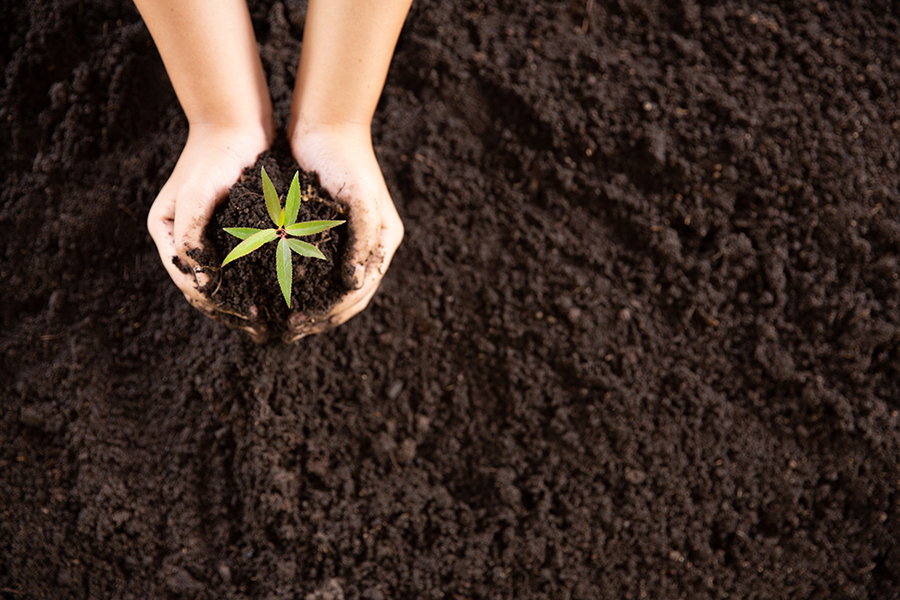With warming environments, landscapes are shifting. But life is still abundant.
When ecologist Craig Allen looks across the brown, grassy shrublands on the east flank of the Jemez Mountains in northern New Mexico, he feels no satisfaction that he was right.
Right that the world was warming. Right that warming would spur such large, severe fires that the forest he studied for decades would disappear. And right that increasing temperatures here—and across the globe—have made it too warm for conifer trees to regain even a toehold across many of their old landscapes.
“It’s hard not to feel…well, it has felt like failure there,” says Allen, who recently retired from the U.S. Geological Survey, and has monitored landscape change in these mountains since he was a Ph.D. student in the late 1970s. “We saw the vulnerability. But we could not act substantively enough, quickly enough to deal with it.”
Across the Earth, people are watching the impacts of climate change play out across their homelands, the places they depend upon and love. From rising seas lapping at the shores and inundating coasts to the highest mountains, where snowpacks are dwindling and glaciers receding, we are reeling from how these changes affect every aspect of our lives. In all of this, there is room for grief. These changes are dangerous and disorienting. But building new relationships with the landscapes around us will allow us to survive—and give the other species we still share this planet with the chance to thrive.
Aside from a few exceptional years, the past two decades have been marked by warmer temperatures and a severe drought that have sucked up snowpacks and streamflows around the U.S. Southwest and northern Mexico. Hand in hand with other human interventions, like fire suppression, drought and warming have made forests increasingly vulnerable to die-offs, insect outbreaks and larger, more severe wildfires.
In the late 1980s, when NASA climate scientist James Hansen testified before the U.S. Congress about the link between human-emitted greenhouse gases and warming, Allen says the impacts of climate change still seemed theoretical. But by the early 1990s, temperatures were clearly rising, and in 1998, he co-authored a paper with David Breshears, looking at how climate change would produce large shifts in forests at “unprecedented rates.”
All too quickly, Allen and his colleagues watched this play out worldwide, including in the Jemez. In 1996, the Dome Fire burned over 16,000 acres of the Santa Fe National Forest and the adjoining Bandelier National Monument. Then in 2000, a prescribed fire ran out of control in the area; the Cerro Grande Fire burned 48,000 acres. Part of the problem in the Jemez, as with millions of acres of forests across the western U.S., lies with a century of fire suppression. By not letting even naturally-ignited fires burn, we allowed our forests to become overly dense and stuffed full of downed and dead trees that now more easily fuel bigger and more catastrophic wildfires.
But warming changed the whole dynamic.
“As soon as we started to go through multiyear drying, society no longer had the capacity to suppress those fires,” Allen says. “If you get an ignition on the wrong day, just forget it.”
That’s what happened when the 2011 Las Conchas Fire ripped through the Jemez with astonishing heat and unprecedented speed. No one had seen a fire like Las Conchas. And modelers still can’t get a grip on it.
Las Conchas ignited around 1 p.m. on a sunny Sunday in late June, shooting a huge, pyrocumulus cloud above the mountains. By 3 a.m., it had burned more than 40,000 acres. In all, it devastated 156,000 acres.
In some places where the highest severity fires burned, aspen groves are replacing the scorched and root-ripped pines that have tipped and fallen. Some scattered pines do survive, but most are skeletons, creaking and whistling in the whipping wind. And within about 30,000 acres of the burn scar, there’s simply no forest. A decade after the fire, it’s dusty. And even in mid-April, the sun feels punishing. No longer a cool, moist conifer forest, this land is now wide open to the Rio Grande Valley below—and covered with tufts of deer-munched grasses, low prickly bushes and a smattering of scrubby Gambel oak.
“It hurts to see the loss of the forest in the Jemez,” says Allen. “There are always winners and losers in change, right?” he says, repeating the mantra ecologists adhere to, that change is inherent in all ecosystems at all time scales.
“There’s life up there,” Allen says. “Abundant life. But it’s not forest life.”
More than 20 years ago, aquatic ecologist Michael Bogan interned with the California Department of Fish and Wildlife in Bishop, east of the Sierra Nevadas. It was 1998, a wet year for California, and the idea of studying water in the desert lodged in his brain.
Desert streams are approachable subjects, especially compared to, say, a massive and murky system like the Mississippi River, says Bogan, now a professor at the University of Arizona’s School of Natural Resources and the Environment: “The entire world is shrunk down to the size of your living room. To understand why something is going on, why the species are there, or why they’re disappearing — you have a pretty good chance of figuring it out.”
For Bogan, studying those small systems over the past two decades has meant witnessing their decline.
When he first started visiting one of his research sites in southern Arizona, French Joe Canyon, he’d hear birds singing from the cottonwood trees as he approached. “It was so full of life all the time. I knew the invertebrates there, I knew the species,” he says. Now, it’s hard to go back. “Most of the time now, it’s dry. The birds are definitely not there, the aquatic species are not there,” he says. “And even when it does have water, it’s not the same species that were there beforehand.”Santa Cruz River, Arizona. (Photo: Elnogalense)
That sense of loss is magnified from knowing change isn’t just occurring at that one living room-sized place he happened to be paying attention to—but knowing that springs and streams are drying up across the entire region, the entire world.
“The scientist in me knows that stasis is a myth, right?” he says. Ten thousand years ago, for example, southern Arizona hosted a forest of Joshua trees, not saguaros. “There was almost no similarity to what you see today. So, the scientist in me knows that nothing is ever stable and things are always changing,” he says. But he still feels grief at the rapid changes we’re experiencing.
To seek out joy, he also studies ecosystems that might persist or that can respond when we make different decisions.
The Santa Cruz River in Tucson, Arizona, had been dry—thanks to rampant development and reckless groundwater pumping—for roughly a century. A few years ago, the local water utility agreed to use its treated effluent to rewater the river.
Some fish species had gone extinct, like an endemic species of pupfish. But they’ve now reintroduced the Gila topminnow and are watching greenery come back, as well as myriad species of dragonflies. Coyotes and bobcats make appearances on game cameras set up along the Santa Cruz.
“That’s a situation where it’s treated wastewater, but where you do it right, where you are purposeful about how you do it, now it does support a lot of species, it shows resilience. It was dry for 100 years, but species are back,” he says. “The birds found it again, the ducks came back, down to the snails, they came back.”
Bogan keeps coming back to the idea of resilience: “French Joe Canyon is not resilient; it’s never coming back unless we enter a new Ice Age period,” he says. “But species themselves, and some ecosystems, they can be resilient if we change our actions, if we change the way we manage our water or other resources.”
Of course, many people already know how to adapt to change: climatic changes, cultural disruptions and shifting relationships with landscapes over lifetimes and generations.
Pueblo people in the Southwest have been adapting to their landscapes since long before colonial times—and they hold within them a “genetic memory of how to have a healthy watershed,” says Julia Bernal. She works on water issues in New Mexico and is executive director of the Pueblo Action Alliance, an environmental and social justice group.
There are 19 pueblos in New Mexico. Each of these Native American tribes is different, and a distinct, sovereign nation. But they share some commonalities, including ancestry traced back to places like Chaco Canyon and Mesa Verde. Bernal is an enrolled tribal member of the Pueblo of Sandia and is also from the Pueblo of Taos and the Yuchi-Creek Nations of Oklahoma.
Since pre-colonial times, Pueblo people have been adapting to their changing climates—migrating due to an epic drought in the 1100s from Chaco Canyon, for example, to live along the Rio Grande.
Today, that river’s waters are damned, diverted and overallocated. The state’s largest river, the Rio Grande now regularly dries up each summer downstream of the city of Albuquerque. And in southern New Mexico, the river channel is dry for most of the year.
Bernal recalls a recent conversation with her dad, who told her about almost falling into the river because it overbanked so much. “That really resonated with me, because I’ve only seen it as a very narrow, channelized system because of the dam,” she says, referring to the Cochiti Dam, built upstream in the 1960s and ’70s by the U.S. Army Corps of Engineers. “I don’t think we’ll ever see the river look the same way that it did,” she says.
The alliance’s movement of reclaiming what was stolen, first by the Spanish and then by the U.S. government, involves the recognition and reclaiming of lands. And waters. “Everything that we do is … for everybody, for the health of the whole because we understand the watershed system as a whole,” she says, adding, “This isn’t about taking all of the water resources. It’s not about taking all the land and not leaving anything for anybody—that’s a capitalist and colonialist concept.”
Bernal challenges non-Indigenous people to think more deeply about what Indigenous-led movements are trying to do. And to recognize they will benefit the global majority, particularly in this climate-changed world. “Some people think ‘decolonizing’ means we go back centuries,” she says. What it really means is having choices—in terms of energy, for example—and learning how to meet the needs of the community by building an economy around particular values.
It’s sad to see changes on the landscape, she says—whether they’re due to development, oil and gas, even recreational infrastructure, or to warming and its impacts. “Unfortunately, we’re going to see more of that; it’s inevitable, and especially at this rate we’re going at right now,” she says.
Whether it’s Bernal’s father recalling the Rio Grande before Cochiti Dam, or Bogan, Allen and others monitoring ecosystems and telling the stories of changing landscapes through the data they collect, storytelling helps us remember the past, and find new ways of living with the future.
Today, when Allen goes out to the burn scars in the Jemez, he says he’s starting now to see it as “normal.” The conifer forest is gone, and it’s not coming back. And this isn’t just happening in the Southwest: Studies over the last decade show that by 2100, at least half of the Northern Hemisphere’s conifer forests will have died due to rising temperatures and the associated impacts.
“It’s a different world,” he says. “But I guess the gut punch of it wore off some time ago, and I’m now more engaged in appreciating and fostering what we have.”
This story originally appeared in Capital And Main and is republished here as part of Covering Climate Now, a global journalism collaboration strengthening coverage of the climate story, of which Real Leaders is a member.




































